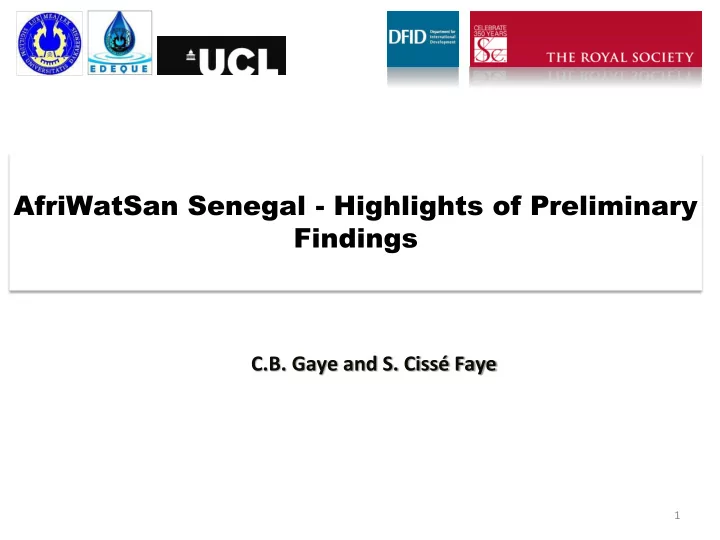

AfriWatSan Senegal - Highlights of Preliminary Findings C.B. Gaye and S. Cissé Faye 1
The water supply of Dakar Daily production : 350000 m 3 / j • 7% s from local aquifers (2% Thiaroye – shallow sand, 5% NIB - volcanic); • 39% derives from surface water from Lac de Guiers (23% - KMS, 16% is Nguith) and • the remaining 54% derives from northern littoral (coastal) aquifers (19% from sandy aquifer Littoral North and Kell; 35% from Horst sand aquifer and surrounded by Paleocene limestone)
Thiaroye aquifer - show case of aquifer eutrophication High rate of urbanization critical problems in providing adequate water supply and sanitation systems ❑ Soudano-sahalien climate ❑ 14°25 ’ et 15°5 ’ N ❑ It extends as a peninsula 50 km in with Oceanic Influence ❑ 16°55 ’ et 17°32 W the W-N Direction
✓ ENVIRONMENTAL SETTING Study area Thiaroye peri -urban area Coastal zone & Lac Retba 4
Hundreds of thousands of septic tanks and a major municipal landfills Mbeubeuss Drainage and waste
Fertilizers and pesticides use in the practice of urban agriculture. Groundwater quality has deteriorated substantially with nitrate concentrations in excess of 500 mg·L -1 where on-site sanitation facilities dominate
Eutrophication resulted in drastic decrease of exploitation rate Changes in the exploitation of the Thiaroye aquifer due to increase in nitrate content for the period 1952 - 2011
Urban flooding with rise in groundwater level due to the lowering of the pumping rate; and contribution from rain-fed recharge and septic effluent to urban groundwater budget
AfriWatSan AfriWatSan five years research project funded by the Royal Society / DFID (2015 – 2020) ❑ Scientific evidence required to inform policies and practices that sustain the quantity and quality of urban low cost water supply and sanitation systems exploiting the sub-surface in Sub- Saharan Africa Urban Groundwater Observatory
PROJECT PROGRESS: Dates works carried out: Results: ➢ 37 hydraulic structures sampled in the ➢ Piezometric map First field From 30/08 ➢ Physico-chemical campaign (wet to study area (7 Boreholes, 5 piezometers, 9 season) 03/09/2016 manual hand pumps and 16 dug wells) analysis ➢ Depht measurement ➢ Chemical analysis ➢ In-situ measurement ➢ Microbiological analysis ➢ Water sampling ➢ 52 hydraulic structures sampled (7 ➢ Piezometric map Second field From 19 to ➢ Physico-chemical campaign (Dry 22/04/2017 Boreholes, 13 piezometers, 6 manual hand season) pumps and 26 dug wells) whose 24 in the analysis ➢ Chemical analysis study area ➢ urban groundwater observatory location ➢ Recording data over ➢ Depht measurement time at a piezometer (depth, ➢ In-situ measurement conductivity, turbidity, ➢ Water sampling salinity, DO, resistivity) ➢ Installation of the first data logger at a ➢ Isotopic analysis monitoring well (P2-6) located to the east of (pending) ➢ Cross-section location the study area
PROJECT PROGRESS: Data- logger setup Sampling network (August 2016) Sampling network (April 2017)
Up-dates Piezometric map Piezometric map of the study area (April 2017)
Water mineralization Water-type and major elements predimonance: ❑ The chemical facies is usually Cl-Na during the wet season; ❑ In the dry season, groundwater become Cl- Ca or HCO 3 -Ca in some sampled points; ❑ This water-type change is caused by Ca and HCO 3 ions increases during the dry season; ❑ increase of major ions in dry season which WHO standard WHO standard show dilution effect by precipitations.
On-site sanitation input (Sanitation facilities) ❑ Advanced spatial tool for determining the number of septic tank Number of septic tank ≈ 253116 High septic Deni, Bayakh, Mbaouane &Kayar Yoff tank density Grand yoff Ouakam in the urban Thiaroye Sur Mer Dalifort area Hann-Bel Air Patte d'Oie (overcrowdi Pikine Ouest Thiaroye Diaksao ng ) Guinaw Rail Nord Guinaw Rail Sud Parcelles Assainies Thiaroye Gare Pikine Nord Pikine Est Diamaguene Sicap Mbao Pikine Ouest camberene Djidah Thiaroye Kaw Medina Gounass Low septic Golf Sud tank density Sam Notaire Wakhinane Nimzatt in the peri Ndiareme Limamoulaye Yeumbeul Sud urban area Yeumbeul Nord Rufisque Ouest Mbao Sanghalkm Keur Massar Malika 0. 13.75 27.5 41.25 55. Fig 2: Density of septic tank or pit (DIAW, 2017) Fig 3 Avearage density of septic tank or pit Fig 4: Density of septic tank or pit per district community (DIAW, 2017)
Statistical model (Association between NO3 Contamination and Septic tank density) Fig 1: Relationship between nitrqte concentration and density of septic tqnk 15 Fig 2: Relationship between nitrqte concentration and density of septic tqnk
FUTURE PLANS Groundwater observatory N°1 16
Groundwater observatory N°2 17
Concluding remarks Adaptive responses to urban groundwater contamination through the importation of water from less-polluted environments but such solutions are constrained not only by the availability of water from remote locations but also the costs of doing so.
Need to better understand the contamination process in order to elaborate groundwater resource management and protection strategies of the urban groundwater.
Results can be potentially replicated in other fast growing cities and used as methodology approach to evaluate the real environmental impact on the quality of groundwater resource particularly in developing countries characterized by burgeoning informal settlements and inadequate sanitation infrastructure.
Thank you
Recommend
More recommend